Scorpion, Part II demonstrates the real strength of the blockbuster two-part episodes scattered across the run of Star Trek: Voyager.
Generally speaking, the two-part episodes of Star Trek: The Next Generation suffered from a sense of disharmony. The two parts seldom felt integrated, often feeling quite disconnected from one another. This was most obvious in the cliffhangers bridging the seasons, when the writing staff would take time away from the office before returning to write the second part. Michael Piller famously had no idea what he was going to do with The Best of Both Worlds, Part II when he wrote The Best of Both Worlds, Part I.

Droning on.
Even for the two-part episodes within a given season, there tended to be a disjointedness. Chain of Command, Part I is very much set-up for Chain of Command, Part II, with the second part feeling much stronger (and more substantial) than the first. Birthright, Part I leads into Birthright, Part II, but also features an entirely unrelated subplot that is dropped completely in the second half. Arguably, The Next Generation only really figured out how to properly balance two-parters in its final season, with Gambit, Part I, Gambit, Part II and All Good Things…
In contrast, Voyager does a much better job of balancing its two-parters so that they feel like two halves of a movie rather than an extended first act followed by a compressed second and third act. Future’s End, Part I and Future’s End, Part II established that template, but Scorpion, Part I and Scorpion, Part II demonstrates that it can applied as readily to season-bridging two-parters as to mid-season sweeps episodes. Scorpion, Part I and Scorpion, Part II integrate beautifully to form an impressive Voyager television movie.

Venting frustration.
Scorpion, Part I and Scorpion, Part II are remarkably well constructed. This is most notable in the rather weak cliffhanger that separates the two episodes. Traditionally, the cliffhanger has been the defining ingredient of a Star Trek two-parter. After all, it is the cliffhanger that is intended to bring the audience back for the second part, whether that second part arrives the following week or several months later. Indeed, there is an argument to be made that the cliffhanger to the season finale is incredibly important. It convinces the audience to return to the show.
However, the cliffhanger can cause problems in structuring a story. Television writers are used to positioning cliffhangers and twists around act breaks, designed to keep the audience hooked during the inevitable commercial breaks. As a result, there is a tendency to think of a closing cliffhanger as a gigantic act break. It is something that changes the audience’s understanding of the situation or the perception of the characters. The problem is that positioning a gigantic twist smack-bang in the middle of a story throws off the pacing.

Borg to death.
Putting a gigantic cliffhanger at the end of the first part of a two-part story means that the first part often feels like it is building to that singular moment, the point at which the plot really kicks into gear. After all, Redemption, Part I and Redemption, Part II are about the Klingon Civil War, but that conflict only begins in the middle of the episode. Time’s Arrow, Part I and Time’s Arrow, Part II are about the crew travelling back in time, but the bulk of the cast only makes the journey at the end of the first episode. And then the second episode rushes to cover all that story.
Star Trek: Deep Space Nine largely eschewed this structure by steering away from conventional two-part episodes. Stories like Improbable Cause and The Die is Cast had two different episode titles, which made it easier to break the story into two clear halves; Improbable Cause is about Odo investigating Garak, while The Die is Cast is about the Cardassians and Romulans attacking the Dominion. More than that, season finales like The Adversary, Broken Link and Call to Arms were not so much cliffhangers as game-changers, radically altering the status quo.
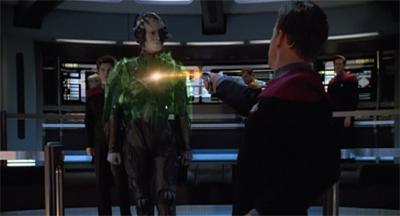
Deflecting attention.
Voyager has its own approach. As a rule, the strongest Voyager two-parters are not built around a singular striking cliffhanger image, but instead function as one distinct story that happens to have a somewhat memorable cliffhanger image in the middle. Future’s End, Part I ends with a sequence of Voyager captured on home video, a distinctive visual that has absolutely no plot bearing on Future’s End, Part II. It is hardly Riker trying to kill Picard in The Best of Both Worlds, Part I or Worf resigning his commission in Redemption, Part I.
In fact, Voyager would so effectively eschew building its two-parters around the cliffhanger that the series would grow into the habit of airing two-part episodes as a double-feature on the same evening. The cliffhangers between The Killing Game, Part I and The Killing Game, Part II or between Dark Frontier, Part I and Dark Frontier, Part II or between Flesh and Blood, Part I and Flesh and Blood, Part II were ultimately little more than act breaks for the audience watching at home on initial broadcast.

Hanging on in there.
While Scorpion, Part I and Scorpion, Part II were separated by almost four months, the same logic applies. The cliffhanger at the end of Scorpion, Part I is largely superfluous. Voyager meets with the Borg to negotiate a truce when Species 8472 attack. Species 8472 blow up a Borg planet, while one Borg Cube takes Voyager in a tractor beam and warps away. However, the teaser to Scorpion, Part II makes it clear that nothing has actually changed. Janeway is still alive, Voyager is still pursuing an alliance with the Borg, Chakotay is still uncomfortable with it.
The bigger moments and twists in Scorpion, Part I and Scorpion, Part II are positioned comfortably either side of the adequate-at-best cliffhanger. Species 8472 are quite thoroughly introduced in Scorpion, Part I, almost killing Harry Kim. Janeway is not incapacitated until several acts into Scorpion, Part II, at which point a bunch of Borg drones invite themselves on board Voyager and begin to assimilate the cargo bay. Either of those story beats would make for a more compelling or effective cliffhanger to whet the audience’s appetite.
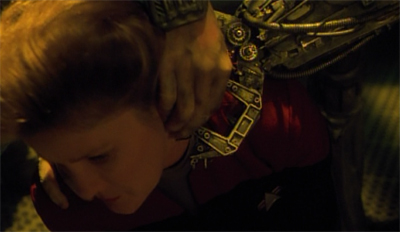
Janeway puts her neck on the line.
However, it is to the credit of writers Brannon Braga and Joe Menosky that they are more invested in the flow of the two-parter than the demand of the cliffhangers. Holding back the reveal of Species 8472 until the climax of Scorpion, Part I might have left the episode feeling shallow and over-extended. Pulling Janeway’s coma forward from the midpoint of Scorpion, Part II would have made it harder to introduce the character of Seven of Nine. The middling cliffhanger feels like a reasonable price to pay for an episode that holds together this well.
It is clear that Braga and Menosky had some idea of what they were going to do in Scorpion, Part II as they sat down to Scorpion, Part I. Brannon Braga has acknowledged that the idea for the two-parter came to him with the idea for Seven of Nine, a character who only appears in Scorpion, Part II. Even in terms of storytelling, the disagreement between Chakotay and Janeway towards the end of Scorpion, Part I serves to set up a character conflict that only materialises half-way through Scorpion, Part II. The cliffhanger is not the organising principle here.
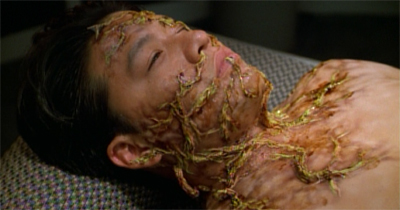
It’s really eating him up.
Still, there are obviously some creative decisions that were made behind the scenes that require some tweaking of the overall plotting of the two-parter. Most notably, Scorpion, Part II rather hastily tidies away Harry Kim’s infection after Scorpion, Part I put such effort into building it up. As Garrett Wang complained in Braving the Unknown:
I mean, I wasn’t too happy that, most of the episode, I was on a bio-bed with green goop on my face. ‘Who else but Kim needs to be tortured in the bio-bed?’, you know? No one else, just Kim.
It seems as though Scorpion, Part I is building that plot thread to go somewhere more interesting than “… and then he got better”, but Scorpion, Part II quickly dismisses it with some casual exposition. There are rumours that Garrett Wang was to have been fired from Voyager in its fourth season, to make room for the addition of Jeri Ryan.

Let sleeping Borg lie.
Wang has acknowledged that the producers almost fired him due to his tardiness during the third season, which had resulted in the actor being cut from Fair Trade and Blood Fever. There are other factors that put Wang at risk. Wang has talked at length about his very vocal and public disagreements with producer Rick Berman:
That’s what happens when you sit there and you tell it like it is to people who have power; they don’t like it. I’m the only person who’s ever publicly spoken about anything regarding Rick Berman in a negative way. This is a free country. You’re entitled to your criticisms and I think my criticisms were valid. I think most people, other actors or people who work on the show, if you pulled them off on an aside and said “Okay, there’s no Rick around. Let me ask you, what do you think of what I said?” I think 99% of them would say “I agree with you that he didn’t take the risks he could have.” That’s all I said and it was in reference to the fact that the man came in, took over from Gene Roddenberry, plugged in a formula and kept that same formula for Next Generation, every episode of Deep Space Nine, every episode of Voyager and after a while, you’re talking about 21 years worth of episodes. Man, you better start changing your formula a little bit just to keep it fresh.
Look at TV today. Look how edgy it is. Look at something like The Shield. Look at Nip/Tuck. Some of these shows are just going above and beyond what anybody’s ever seen. That’s all I said to Rick, who is somebody used to nobody saying anything negative about him publicly. I’m sure he saw this and was like “Okay, fine. Alright. You wanna do that? You want to play hardball? I’ll show you what hardball is.” The result of that is I’m the first actor in the history of Star Trek to be refused a directing job.
Wang traces Berman’s dislike of him back to a comment that he made “off the record” to a TV Guide journalist early in the show’s run. If any member of the cast had to be jettisoned to make room of Seven of Nine, Harry Kim looked like the most logical candidate. After it all, it wasn’t as if the writers were doing anything with him.
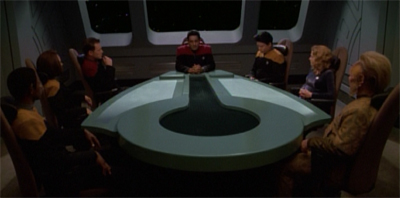
“So, public vote, then?”
However, he was also featured quite highly on the list of People Magazine’s “Fifty Most Beautiful People” after production wrapped on Scorpion, Part II, which may have solidified his position on the cast and saved him from the chopping block. Wang credits his ranking on the list to a convention appearance:
I dug a little further and found out that somebody had been in the audience when I was on stage at a Starcon event in Denver, Colorado. There were probably about 3,000 people there, so it was a pretty big turnout. Everyone could see what was going on and I remember that was probably one of my best stage presentations ever. Everything flowed into everything else and there were funny things that happened along the way. For instance, I was wearing an Armani suit on stage and I hadn’t zipped up my zipper. People had been waving at me and my girlfriend was in the audience, so she had seen it, and they were trying to get my attention. I finally talked to somebody about 20 minutes into it and they told me “You have to zip up your zipper.” I’m like “Oh, my God.” (laughing) And, of course, I didn’t hide it. I told the audience everything and they just started cracking up, but even mishaps like that just fed into everything.When I got off stage, Armin Shimerman was sitting there because he was going on after me, and he told me “Oh, my God. You were unbelievable! How am I going to follow that? You blew them away.” It turns out that somebody in that audience had some connection with People Magazine and called their people at People and said “Listen, there’s this kid…why not him?” And boom, it happened. In the history of Trek, it’s just me and Patrick Stewart. You know, that’s pretty good company to be in who have made the 50 Most Beautiful People.
Ultimately, the production team would decide to sacrifice Jennifer Lien to make room for Jeri Ryan in The Gift. This explains why the Scorpion, Part II so cleanly and so effectively drops that major plot thread from Scorpion, Part I without any real fanfare or excitement.
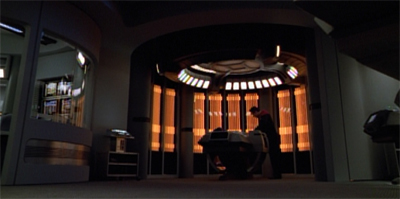
Commanding presence.
Allowing for that exception, Scorpion, Part II carries over quite a lot of thematic and plot material from Scorpion, Part I. The episode hinges on the emotional conflict between Chakotay and Janeway over the alliance with the Borg. It is a very clever storytelling decision, one that keeps Scorpion, Part II grounded in the characters and their dynamic even as an epic conflict unfolds around them. The setting up of the schism between Janeway and Chakotay in Scorpion, Part I and the pay-off of that premise in Scorpion, Part II might be the strongest part of the episode.
The relationship between Janeway and Chakotay is possibly the strongest character dynamic on Voyager at this point in the run. Voyager has struggled to develop strong bonds between its cast to match those on The Next Generation or Deep Space Nine. After all, Tom Paris and Harry Kim are nowhere near as interesting as Data and Geordi LaForge or Julian Bashir and Miles Edward O’Brien. However, episodes like The Cloud and Coda have demonstrated that Janeway and Chakotay do have a compelling relationship.
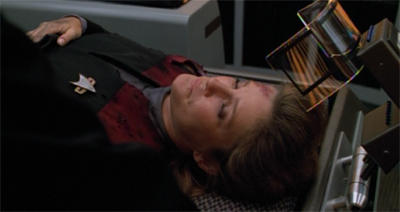
Healing their rift.
The most obvious (and superficial) explanation for the intriguing dynamic between Chakotay and Janeway is romantic and sexual in nature. Janeway and Chakotay clearly harbour some romantic or sexual affection for one another, with show explicitly acknowledging Chakotay’s love for Janeway in Resolutions while also contorting awkwardly to avoid any long-term consequences from that declaration. Indeed, Resolutions is such a wishy-washy piece of television that it can read to imply any number of possibilities.
However, there is more to the dynamic between Janeway and Chakotay than simple attraction. Unlike any other Star Trek series, Janeway and Chakotay were both commanding officers when they first met in Caretaker. Janeway was in command of Voyager, while Chakotay was in command of the Val Jean. Although Voyager has never done much to really sell the crew’s sense of loneliness and isolation, it is clear that Janeway and Chakotay are the only characters on the show to understand completely the burden (and responsibility) of command.

They’ll never see eye-to-eye on this.
This is what makes the clash in Scorpion, Part I and Scorpion, Part II so compelling. Although Voyager lacked the courage to fully explore the implications of merging two very different crews in pursuit of a common purpose, Voyager is a ship that has two captains. Chakotay has accepted a subservient role to that of Janeway, but he also understands what it means to lead a crew of people. When Janeway is incapacitated in Scorpion, Part II, Chakotay is not stepping into a command position for the first time. Instead, he resuming his command responsibilities.
This is a small, but important, distinction that helps to differentiate Chakotay’s arc in Scorpion, Part II from Riker’s arc in The Best of Both Worlds, Part II. It is a very subtle contrast, but it is there. Riker has to learn an important lesson about being his own man, whereas Chakotay grabs the bull by the horns straight away. When the Borg begin making demands, Chakotay seizes the opportunity to dissolve an alliance that he never supported. He does the bare minimum to ensure continuity of command and respect Janeway’s wishes before making his own decision.
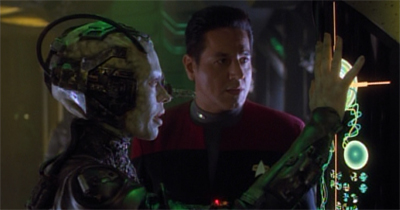
“Let me check our Borganisational chart.”
The confrontation between Janeway and Chakotay in sick bay is one of Voyager‘s strongest character-driven moments. “In my mind, the alliance was already over,” Chakotay insists. Janeway responds, “You never trusted me. You never believed this would work. You were just waiting for an opportunity to circumvent my orders.” It feels like a very visceral and personal betrayal. “Trust had nothing to with it,” Chakotay assures her. “I made a tactical decision.” In this scene, Janeway and Chakotay feel more like real people than they do for most of the rest of the run.
As with Worst Case Scenario, there are interesting hints at an alternative version of Chakotay. Robert Beltran was never the franchise’s most charismatic performer, but the writers never developed Chakotay into a compelling and multifaceted character. Ever since the staff (correctly) jettisoned the New Age mumbo jumbo of episodes like Tattoo or Basics, Part I, the writers have struggled to find a niche for the character. Scorpion, Part I and Scorpion, Part II afford Chakotay a sense of agency that he sorely lacks in other episodes.
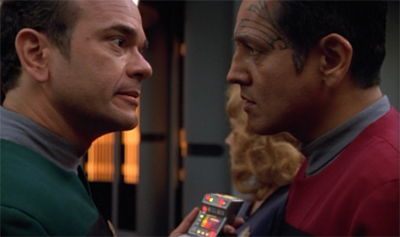
“I’m sorry, Commander. But I’m just not detecting any chemistry.”
Indeed, there is even a sense of character continuity to Chakotay’s character arc in Scorpion, Part I and Scorpion, Part II. His motivation is rooted in more than just plot necessity, instead informed by his experiences with the Borg Collective in Unity. Arguing with Janeway about whether they can trust the Borg Collective, he reminds her, “I was linked to a Collective once, remember? I had a neurotransceiver embedded in my spine. I know who we’re dealing with. We’ve got to get rid of that last Borg and take our chances alone.”
Of course, that character beat is shamelessly recycled from Picard’s character arc in I, Borg and Star Trek: First Contact, and suffers from the fact that Robert Beltran is no Patrick Stewart. Then again, a lot of Scorpion, Part I and Scorpion, Part II plays like a mix tape of “Best Borg Stories ’97.” The first officer steps into a command position and our heroes tap into the mind of an isolated Borg drone as in The Best of Both Worlds, Part II. The Borg threaten to assimilate the ship and a character deals with post-assimilation trauma as in First Contact.

“The line must be drawn here. Or maybe over there, just outside the cargo bay.”
Given all that, it doesn’t really matter that Chakotay’s motivations are borrowed from The Next Generation. It only matters that his judgement is impaired. The beauty of the conflict between Janeway and Chakotay in Scorpion, Part I and Scorpion, Part II is the sense that both characters are right and both characters are wrong. Chakotay is right that the Borg will betray them, but is blinded by his past experiences with them. Janeway is right that Species 8472 must be stopped, but is compromised by her unwavering insistence on getting her crew home no matter the cost.
In fact, Scorpion, Part I and Scorpion, Part II do an excellent job of tying this character conflict back into the theme of transhumanism embodied by the Borg. The Borg Collective is presented as an alternative to this discord and disagreement. In explaining his eagerness to incorporate the Borg into Voyager, Brannon Braga discussed plans to develop the Collective in the same way that The Next Generation and Deep Space Nine developed the Klingons. In order for that approach to work, Voyager needs to be willing to look at the universe from the perspective of the Borg.
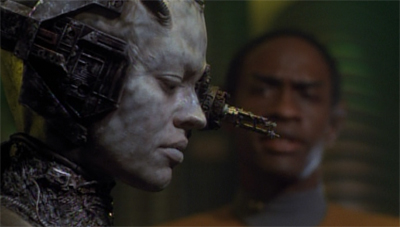
Seventh heaven.
Although Voyager never manages to consistently embrace the Borg Collective’s perspective, Scorpion, Part I and Scorpion, Part II does an excellent job. “When your Captain first approached us, we suspected that an agreement with humans would prove impossible to maintain,” Seven of Nine suggests to Chakotay. “You are erratic, conflicted, disorganised. Every decision is debated, every action questioned. Every individual entitled to their own small opinion. You lack harmony, cohesion, greatness. It will be your undoing.”
In order for an alien culture to make sense, their way of looking at the world around them needs to make sense. The best alien species on Star Trek are not simply strange or unknown, but instead provide a compelling alternative understanding of the mechanics of the universe. Deep Space Nine largely redeemed the Ferengi by inviting viewers to contrast their unapologetic capitalism with the politicking other major powers. Here, the harmony of the Borg Collective is contrasted with the discord on Voyager. It is an effective juxtaposition.
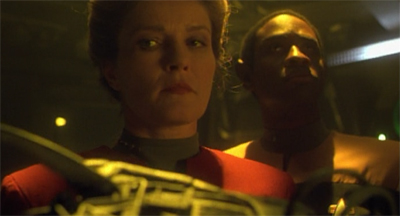
See that no arm comes to them.
Given how skilfully Scorpion, Part I and Scorpion, Part II employ the relationship between Janeway and Chakotey, there is something disheartening in the change that they heralded for Voyager as a television series. As with Deep Space Nine, there were concerns about the ratings heading into the fourth season of the Voyager. Quite simply, the show was not performing as it needed to. It was losing viewers compared to The Next Generation, an acknowledgement that the franchise was in a decline that would eventually culminate in cancellation.
As with Deep Space Nine, it was decided that the production team would try to shore up ratings by adding a new character in the fourth season premiere. While Deep Space Nine had chosen to add a pre-existing character in the form of Lieutenant Commander Worf as played by Michael Dorn, the production team working on Voyager opted to add an entirely new character to the cast. Indeed, Scorpion, Part I and Scorpion, Part II were largely built around introducing and establishing this new character.
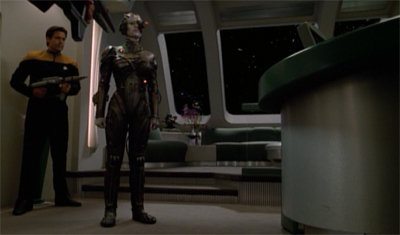
Contract negotiations were tense.
Scorpion, Part II introduces the character of Seven of Nine, as conceived by Brannon Braga as a twist on an archetypal Star Trek character:
The show needed a kick in the ass. Creatively, we needed something. A Star Trek series, in my opinion, is only as good as its captain, and Captain Janeway was a great captain, but she didn’t have her Spock or Data, really. We just didn’t have that special science-fiction character like Spock or Data, the striving-to-be-human character. The idea of putting a Borg on board gave us a chance to have a wild child there. That was the metaphor, a wild child, and Janeway would be her mother and try to tame her and help make her human again. That was a new take on that kind of character.
Braga is selling Voyager short here. Tuvok was a character who could easily have served the same function as Spock, while the EMH was very close in character to Data. In some aspects of her concept, Seven of Nine feels redundant.

Logging her concern.
Seven of Nine would become one of the most divisive characters in the Star Trek canon. As with a lot of the big creative controversies surrounding Voyager, the problem was one of execution rather than concept. Introducing a new character half-way through the run of a seven-season show is a risky proposition. It can be difficult to successfully integrate a new character (and a new performer) into an established ensemble. There will always be a temptation to focus on this new character to the detriment of the rest of the cast.
To its credit, the fourth season of Deep Space Nine had done an excellent job of introducing Worf without overwhelming the rest of the show’s characters. Although Worf is the focus of subplots in episodes like Hippocratic Oath and Bar Association, the writers were careful to ensure that Worf never squeezed other cast members out of the spotlight. In his first season, Worf is only really the focus of The Sword of Kahless, Sons of Mogh and Rules of Engagement. Tellingly, the first Worf-centric episode comes nine episodes into the season of twenty-six episodes.
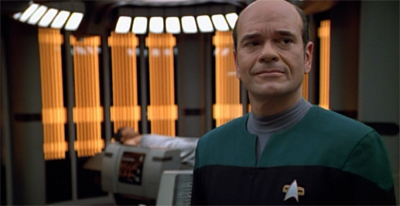
“Well, at least it won’t affect my screen time.”
However, Deep Space Nine was a show that was always conscious of its ensemble. It put in the hours to flesh out and develop problem characters like Julian Bashir, when it would have been much easier to forget about them completely. This led to painful episodes in the first three seasons; The Passenger, Melora, Distant Voices. However, it also meant that the show understood all of its characters perfectly before Worf arrived. Deep Space Nine produced three brilliant Bashir-centric episodes in Worf’s first season; Hippocratic Oath, Our Man Bashir, The Quickening.
Voyager quite simply never put that work into its supporting cast. The writers have largely given up on characters like Chakotay or Tuvok or Harry Kim. Even Kes was largely forgotten during the third season, used largely as a plot device in stories like Warlord and Before and After. These were characters fighting for breadcrumbs even before Seven of Nine was introduced. These characters become forgotten members of the ensemble, lucky to be thrown a token character-driven episode once a year while the writers focus their attention on the new arrival.

A sting in the tale.
I guess when Brannon Braga took over, when the Seven of Nine character made her entrance, the focus changed. That was fine with me. That was fine with me, but I think writers have an obligation to fill out all the characters if they’re regular characters on a series. I think several of the characters were diminished – Chakotay and Tuvok and Kim and Neelix. I think it was just easier for these new writers that came on to write stories about the captain and about characters that weren’t really human, like Seven of Nine and the Doctor. Those three characters were kind of all-seeing, all-knowing, omnipotent, and I think a lot of the tension and drama that was available was lost because you have to really dig hard to find tension in all-knowing, all-seeing characters. They know everything, right? They have all the answers. Or else you have a redundancy of the same scene written over and over and over again, with slight variations.
In the seasons that followed, Beltran would become a vocal critic of the Voyager writing staff, calling them out at every opportunity. This would only contribute to an increasingly toxic atmosphere on set.

You can see the “8” in its eyes.
However, all of that lies ahead. Scorpion, Part I and Scorpion, Part II represent a turning point for Voyager in a number of contrasting and complicated ways, introducing a new character and radically altering the tone of the show. And yet, the two episodes combine to form a compelling and intriguing two-part adventure that ranks among the best stories that Voyager has ever produced. The fox is almost half-way across the stream, but it has yet to feel the scorpion sting.
You might be interested in our other reviews from the fourth season of Star Trek: Voyager:
- Scorpion, Part II
- The Gift
- Day of Honor
- Nemesis
- Revulsion
- The Raven
- Scientific Method
- Year of Hell, Part I
- Year of Hell, Part II
- Random Thoughts
- Concerning Flight
- Mortal Coil
- Waking Moments
- Message in a Bottle
- Hunters
- Prey
- Retrospect
- The Killing Game, Part I
- The Killing Game, Part II
- Vis à Vis
- The Omega Directive
- Unforgettable
- Living Witness
- Demon
- One
- Hope and Fear
Filed under: Voyager | Tagged: borg, chakotay, jeri ryan, Robert Beltran, scorpion, seven of nine, star trek, star trek: voyager |




















“In contrast, Voyager does a much better job of balancing its two-parters so that they feel like two halves of a movie rather than an extended first act followed by a compressed second and third act.” That may be so, but I think Voyager’s part ones were almost always stronger than their part twos. Dark Frontier, Equinox, and Flesh and Blood, all have strong first parts that raise interesting questions, while the second parts tend to have weak climaxes that feel overly rushed and eliminate the grey areas that are present in Equinox and Flesh and Blood. The exception is Unimatrix Zero, which is terrible in both part one and part two.
Even this episode, one the best two parters in Star Trek’s history, is stronger in part one. I find the episode’s making Kes like Deanna Troi during the battle with species 8472 especially grating,
I was actually considering citing Equinox as the counter-example, because there is a huge drop in quality between the two parts there. And I suspect that the changes in personnel between seasons played a part of that. Equinox, Part II feels like the perfect Ronald Moore episode that has been pulled back to something much safer and cleaner, in contrast to the edgy-for-Voyager opening part.
But I think that Future’s End, Scorpion, Year of Hell and The Killing Game all have roughly equivalent first and second parts. I think I felt the same way about Workforce, but it’s been so long since I’ve seen it. I had issues with Dark Frontier, but I’m not sure it’s an issue with quality so much as conscious storytelling choices. I mean, c’mon. Just give us a two-part “Borg Heist!” adventure.
What’s your plan for future reviews now, more Voyager and DS9? I’ve been looking forward to your thoughts about Voyager once Seven arrives.
The plan should be business as usual through the first half of the fourth season of Voyager and DS9. Three posts a week, in broadcast order. There’s no way I’ll got Voyager finished before Discovery launches, but I might get DS9 covered. But, given Fuller’s step away from Discovery, that is less of a concern than it was.
I may need to take a break in the middle or cut down, due to personal commitments and the Audi Dublin International Film Festival. I’d expect the last few weeks of February to drop down to two posts a week before climbing back to three in early March.
Not sure about longer-term. Probably finish Voyager and then drop back and finish TNG and TAS. May even slow the Star Trek review post rate to once or twice per week at that point, as I have a host of other long-term commitments that I want to honour and opportunities that I want to pursue.
The fourth season of Voyager would see quite a few changes to the series: the departure of Jennifer Lien; Tom and B’Elanna became a couple; Kes helped Voyager make some real progress on its way back to the Alpha Quadrant, but of course the biggest change is the addition of Jeri Ryan as liberated Borg drone Seven of Nine.
At the time of Scorpion, Pt II it was felt that the series needed a new element in order to give the flagging show a shot in the arm – the result was Seven of Nine. The idea of an ex-Borg joining the crew of Voyager was quite a novelty, perhaps more so than Worf jumping ship to DS9 all in the name of ratings in its fourth season. Jeri Ryan was best known for the shortlived series Dark Skies, a SF collision between The X-Files and the classic 60s show The Invaders that was canned after one series but I thought Ryan was very good in it.
She makes an immediate impression on Scorpion from the moment she emerges from a Borg alcove serving as the mouthpiece of the Collective to work with (order around) Janeway and Tuvok. It’s been observed that perhaps she is too individualistic for a Borg drone (it’s also been observed that Seven is being groomed to be the new Borg Queen) but Ryan’s performance is so impressive that she quite literally personifies the will of the Borg Collective – unflinching and uncompromising in they’re plans to assimilate the galaxy and beyond.
The series would eventually come to focus on Jeri Ryan too often, robbing the other cast members of much needed screentime but it doesn’t hurt Scorpion too much. In fact, it adds greatly to the whole tone of the episode. At this stage, she’s not an ex-Borg trying to recover her lost humanity but a Borg drone ruthless in her desire to see the Collective prevail over this new enemy they’ve made through they’re own arrogance. Jeri Ryan makes Seven of Nine a real force of nature, and it is her beautifully modulated performance that solidifies Scorpion, Pt II and ensures it never becomes a rehash or a disappointing conclusion to a stunning two-part story.
Employing a different director (Winrich Kolbe) doesn’t hurt the episode or disrupt continuity either. Scorpion, Pt II maintains the excitement and tension level of the first part (mainly whenever Ryan is around) and although it sidelines Janeway for an act, it does give Chakotay the chance to rise to the occasion and give an interesting dynamic to the story, as he’s much less invested in Voyager’s pact with the Borg (with good reason, as it turns out) and shows he’s quite eager to dissolve it when the first opportunity arises.
Species 8472 continue to be an impressive adversary (even if they didn’t start the conflict as first thought) and Voyager’s alliance with the Borg turns out to be an even more uneasy one than Sisko’s with the Dominion in To the Death. Scorpion is the first Trek two-parter where the flow is completely seamless and either part satisfies on their own terms and sets a very high standard for the season to follow.
Did you mean Darren “The Adversary, Broken Link and Call to Arms were not so much cliffhangers but game-changers?” I like scenes between Data and LaForge but I love scenes between Data and Worf more – they both give an outsiders opinion on the human condition and I only wish they had been paired up in TNG more often. Worf should have been the focus of Rules of Engagement but I felt he wasn’t, much like Dax in the S1 episode, er…Dax. And how about this during Chakotay and Seven’s confrontation – “They’ll never see eye to eyes on this”.
I think you’re right about the importance of Scorpion as a season-bridging two-parter that maintains a consistent quality across the production gap. It is a very rare feat, to the point that Scorpion feels more like a mid-season two-parter like Year of Hell or The Killing Game, as opposed to something like Equinox.
Chakotay assures her. “I made a tactical decision.”
And he was RIGHT. Another example of Janeway being wrong and not admitting it in the end. It was HER original plan not to give the Borg anything until Voyager was far away. Chakotay was only following through on that plan, but Janeway was totally angry at him for not changing the plan the way the Borg wanted. So Seven of Nine, still being a Borg, forces the situation by putting Voyager into fluidic space and they get chased back out by species 8472. This forces Voyager to use the new weapons and destroy some ships. This scares all of 8472 ships back home (because miraculously all their ships in Borg space instantly became aware of some of their comrades being blown up). And where is Voyager at this point?…far from the Borg because Chakotay didn’t turn the ship around. If Janeway had her way, they’d be right up with the Borg and give them the torpedoes and let the Borg do the killing of 8472 to scare them off….and then Voyager would have been assimilated. Months later, Janeway was also wrong in the episode “Prey” with the Hirogen when she got mad at Seven who also saved the ship.